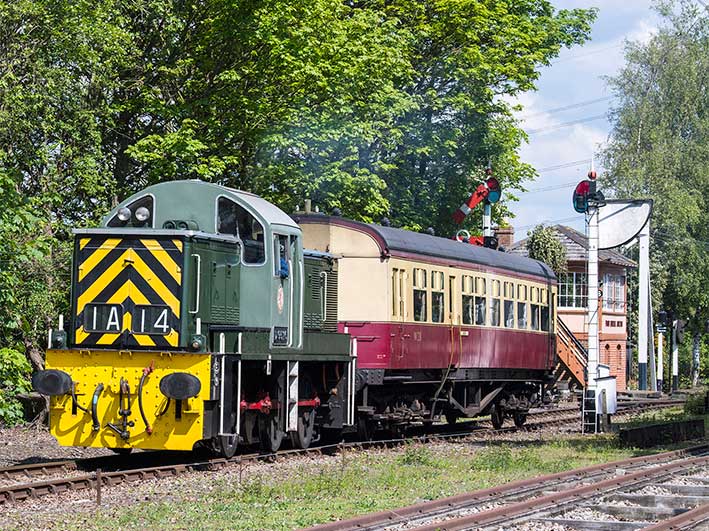Home » Explore » Locomotives & Rolling Stock » Locomotives » Diesel and Gas Turbine Locomotives » D9516 - 'Teddy Bear' - D9516 - 'Teddy Bear'
D9516 - 'Teddy Bear'

Twenty-six of these 0-6-0 locomotives were ordered from Swindon Works in January 1963, with the order being expanded to 56 shortly afterwards. The first of the class entered service in July 1964. At one time there was an expectation that up to three hundred might be required, with the class perhaps becoming as ubiquitous as the pannier tanks which they effectively replaced. The locomotives were later designated as TOPS Class 14 by British Railways, though none lasted long enough in the service of that company to carry the new code. The class is perhaps better known as 'Teddy Bears' by enthusiasts.
The anticipated work for this class was yard shunting, trip work and short distance freight trains across the Western Region, in particular for that traffic generated by the South Wales coalfield. As such, their time in front-line service was destined to be short-lived as this type of work was already in steep decline by the time they were ordered, and virtually disappeared with the implementation of the Beeching report a few years later. The majority of the locomotives were initially allocated to Ebbw Junction, Bath Road, Worcester and Landore. In 1965, four locomotives, D9521-4, were re-allocated to Old Oak Common for trip working trials in the London area. Towards the end of that year they were outbased at Reading and rostered into three diagrams covering freight and parcels trains to Newbury, Didcot, Southall and Basingstoke with one turn also covering parcel work between Reading and Paddington. In 1966 the entire class was reallocated to the North East region at Hull Dairycoates and the class was finally withdrawn, from there, in 1968. However, rather than being scrapped, such new and powerful machines were in demand for privately run rail systems, primarily those of the National Coal Board (NCB) and British Steel Corporation (BSC) and worked on their lines in large numbers for many years before entering preservation. 19 of the 56 locomotives built have been preserved.
The locomotives were powered by a Paxman 6-cylinder Ventura 6YJXL engine producing 650 bhp (485 kW), connected to a Voith L217U hydraulic transmission and Hunslet gearbox. The axles were connected by coupling rods and driven by a jackshaft located under the cab, between the second and third axles.
D9516 was built at Swindon, entering traffic in October 1964, but by 1966 was already to be found stored out of use, at Worcester, with many of its classmates. With the rest of the class it was reallocated to Hull Dairycoates in December of that year and was withdrawn from British Railways' service in April 1968 after a mere three and a half years service. It was purchased by Stewarts and Lloyds Minerals (subsequently part of the British Steel Corporation) and renumbered as their No.36, initially going to work at Buckminster Ironstone Quarry near Stainby in Lincolnshire and then transferring to BSC Corby. D9516 was preserved in 1981, by the late Gerald Boden, and ran on the Nene Valley Railway. It was sold to the Wensleydale Railway in 2011 before being purchased for Didcot Railway Centre in 2014. The locomotive arrived at Didcot in May 2014.
- Status
- Operational
- Build date
- 1964
- Built at
- British Railways, Swindon
- Original railway
- British Railways
- Wheel arrangement
- 0-6-0
- Tractive effort
- 30910 lbs
- Weight
- 48 tons 10cwt.
- Wheel diameter
- 4 feet 0 inches
- Engine
- Paxman Ventura 6YJXL
- Power Output
- 650 bhp
- Power Type
- Diesel Hydraulic
- Transmission
- Voith L217U Hydraulic
 |
 |
 |
 |
Didcot Railway Centre Newsletter
Stay up to date with events and what's going on at Didcot Railway Centre.
You may unsubscribe at any time. We do not share your data with 3rd parties.





